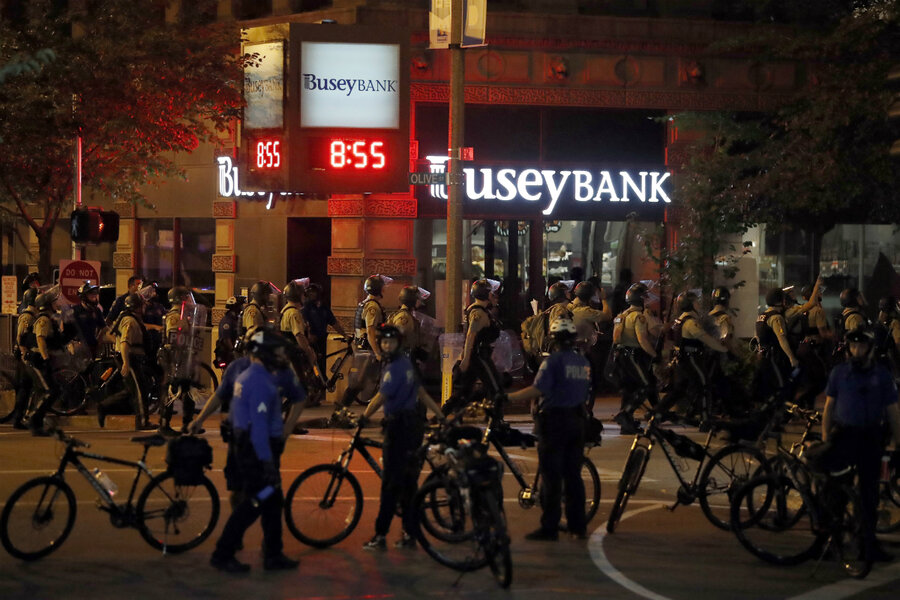St. Louis faces new wave of protests after police ruling
Loading...
| St. Louis
Hundreds of riot police mobilized in downtown St. Louis overnight, arresting more than 80 people and seizing weapons amid reports of property damage and vandalism following another day of peaceful protests over a former police officer's acquittal in the killing of a black man.
The arrests late Sunday came after demonstrators ignored orders to disperse, police said.
"I'm proud to tell you the city of St. Louis is safe and the police owned tonight," Interim Police Chief Lawrence O'Toole said at a news conference early Monday.
A judge ruled Friday that Jason Stockley, who left the police department and moved to Houston three years ago, was not guilty in the 2011 death of Anthony Lamar Smith. The ruling set off raucous protests throughout the weekend. Another peaceful demonstration was expected Monday.
On Sunday, more than 1,000 people gathered at police headquarters then marched without trouble through downtown St. Louis, the posh Central West End, and the trendy Delmar Loop area of nearby University City. Protesters also marched through two shopping malls in a wealthy area of St. Louis County.
By nightfall, most had gone home. The 100 or so people who remained grew increasingly agitated as they marched back toward downtown. Along the way, they knocked over planters, broke windows at a few shops and hotels, and scattered plastic chairs at an outdoor venue.
According to police, the demonstrators then sprayed bottles with an unknown substance on officers.
One officer suffered a leg injury and was taken to a hospital. His condition wasn't known.
Soon afterward, buses brought in additional officers in riot gear, and police scoured downtown deep into the night, making arrests and seizing at least five weapons, according to Mr. O'Toole. Later, officers in riot gear gathered alongside a city boulevard chanting "whose street, our street" – a common refrain used by the protesters – after clearing the street of demonstrators and onlookers.
"We're in control. This is our city and we're going to protect it," O'Toole said.
Mayor Lyda Krewson said at the same Monday news conference that "the days have been calm and the nights have been destructive" and that "destruction cannot be tolerated."
The recent St. Louis protests follow a pattern seen since the August 2014 killing of Michael Brown in nearby Ferguson: The majority of demonstrators, though angry, are law-abiding. But as the night wears on, a subsection emerges, a different crowd more willing to confront police, sometimes to the point of clashes.
Protest organizer Anthony Bell said he understands why some act out: While change can come through peaceful protests, such as those led by Dr. Martin Luther King Jr., years of oppression has caused some to turn violent.
"I do not say the [violent] demonstrators are wrong, but I believe peaceful demonstrations are the best," Mr. Bell said.
State Rep. Bruce Franks, a Democrat who has participated in the peaceful protests, said those behind the violence "are not protesters."
The late night unrest since the verdict was issued has led to destruction across the St. Louis area. It was after nightfall Friday that people shattered a window at the home of Mayor Lynda Krewson, smashed about two dozen windows, and threw trash cans and rocks at police in University City on Saturday, and knocked out windows downtown on Sunday.
Many protesters believe police provoked demonstrators by showing up in riot gear and armored vehicles; police said they had no choice but to protect themselves once protesters started throwing things at them.
Democratic Rep. Michael Butler said police should target the agitators and allow others to continue demonstrating. He protested Friday, and after that said police have been doing a poor job of identifying bad actors in the crowds.
"There's not been any learning from Ferguson," Mr. Butler said.
Mr. Stockley shot Mr. Smith after high-speed chase as officers tried to arrest Smith and his partner in a suspected drug deal.
Stockley testified he felt endangered because he saw Smith holding a silver revolver when Smith backed his car toward the officers and sped away.
Prosecutors said Stockley planted a gun in Smith's car after the shooting. The officer's DNA was on the weapon but Smith's wasn't. Dashcam video from Stockley's cruiser recorded him saying he was "going to kill this [expletive]." Less than a minute later, he shot Smith five times.
Stockley's lawyer dismissed the comment as "human emotions" during a dangerous pursuit. St. Louis Circuit Judge Timothy Wilson, who said prosecutors didn't prove beyond a reasonable doubt that Stockley murdered Smith, said the statement could be ambiguous.
This story was reported by The Associated Press.







